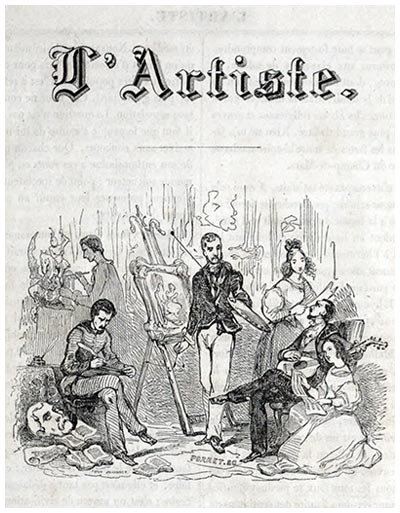On L'Artiste

When Jules Janin wrote in L'Artiste itself the history of L'Artiste, he gave a pompous account of magazine contributors with exclamations, enthusiasm, emotion, sighs and tears for each of them. He also insisted especially on the Johannot brothers for whom he always had a soft spot (they were the illustrators of his book The Dead Donkey) and, redoubling crying, he crushed them under this praise:
Tony Johannot learned, while he worked at L'Artiste, the great art of confining a complete thought in a narrow space. Do not doubt it: had it not been for his education at L'Artiste, Tony Johannot could never have accomplished in such a short time these great works which our age rightly honors; the Molière, Don Quixote, Paul and Virginia, and the soon to come Manon Lescaut, which Tony will make so touching and beautiful!… etc.
But by all means, do doubt it! Before L'Artiste was even created, Tony had illustrated The History of the King of Bohemia. His two hundred Romantic vignettes made him an illustrator and not his six little etchings for L'Artiste!
This perpetual Magnificat sung by the journal in its own honor, this noise conducted around each of its articles, each of its illustrations, around the name of each of its affiliates was the characteristic of L'Artiste. Ah, well, if that was the partiality of L'Artiste when it was at its best, it was also its reason to be and its virtue. As soon as L'Artiste ceased to be this way, it lost all flavor. Was it a society of mutual admiration? Yes, and something else, too: a group that stuck and fought together.
L'Artiste, mouthpiece of Romanticism, was a crusading magazine, a supporter of what was then called youths; that is to say, in a more elevated fashion, a supporter of contemporaries. In art, it fought for Delacroix, Géricault, Decamps, Léopold Robert, Ary Scheffer, Paul Delaroche, Barye, David d’Angers, Berlioz, Meyerbeer. It welcomed Gavarni, Gigoux, the Johannot and Devéria brothers, Louis Boulanger, Roqueplan and hundreds of others.
It was a truly extraordinary thing, the coming at the end of the Restoration of this art journal which appeared, or rather broke out as another Revolution of July, ardent, innovative, Jeune-France[1], taking a stand against the big shots, the philistines, the old wigs, readily enthusiastic, and prone to surges of lasting passion, given in a clear and interesting way. Short articles, easy assimilation, written, as Janin said, with less pretension than the revues and with more talent.
The title page illustration was drawn by Tony Johannot and symbolized Literature and the Arts, but without any sort of ancient allegory, but with gentlemen in velvet jackets and pants with under straps, and ladies with the most genuine 1830s hairstyles, who all paint, sculpt, write or sing ballads while accompanying themselves on the guitar. This illustration is like a motto to which the journal has been eternally faithful: For the Moderns.
Only one among the writers was an exception on this point: Gustave Planche in the theatrical review. He showed himself to be sour and grumpy. One may refer to his articles concerning the Comédie Française:
Traditions and instruction no longer exist at the Théâtre Français. The prolonged sleep of the old repertoire gives Molière, Le Sage and Regnard up to the whims and ignorance of wrinkled old maids and sixty-year-old manservants.
Thus Gustave Planche commits the one unpardonable fault for an art critic: that which consists in refusing to examine art as it is and, instead, to discuss art as he wishes it would be. Looking at contemporary theater while thinking about something else, about his hobby-horse of that “comic poet” we supposedly needed, he worked himself up so much as to declare that we no longer had any theater left (no theater in 1830!) because we only had Victor Hugo, Dumas, Delavigne, Vigny and Scribe!—Hugo, who ignores historical truth.—Dumas, a corrupter who exploits adultery.—Delavigne, a bourgeois.—Vigny, a preacher.—Scribe, who has been giving evidence for the last twenty years that the poor are wrong to be poor and the rich are right to be rich. In conclusion: France awaits a comic poet…!
After the first Romantic ardor had faded away, L'Artiste remained nevertheless a vibrant and innovative journal that is still interesting to read today.
More than any other contemporary work, it was made of such stuff as our own lives, our passions, our flights of enthusiasm. All of the heartbeats of contemporary art, poetry, painting, music, sculpture, and theater are still here and keep resonating for us like Mozart's soul in his violin. And if we wanted an honest history of art and literature and all the splendors of France since 1830, we would only have to take L'Artiste. (Arsène Houssaye: Histoire de L’Artiste).
Translation by OBI
This article is based on Les graveurs du XIXe siècle, Vol. 8 written by Henri Béraldi and published in Paris by Librairie L. Conquet, 1888.
-
- ^ The Jeunes-France were a group of Romantic young men, comprising Théophile Gautier, Achille Devéria, Philotée O'Neddy, Gérard de Nerval, and others. They relentlessly supported Victor Hugo and Alexandre Dumas in the literary wars opposing Classics and Romantics, the most famous of which being fought for Hugo's play Hernani. (Translator's note)
- Image source: L'Artiste tome VI première livraison (ca. 1836).
